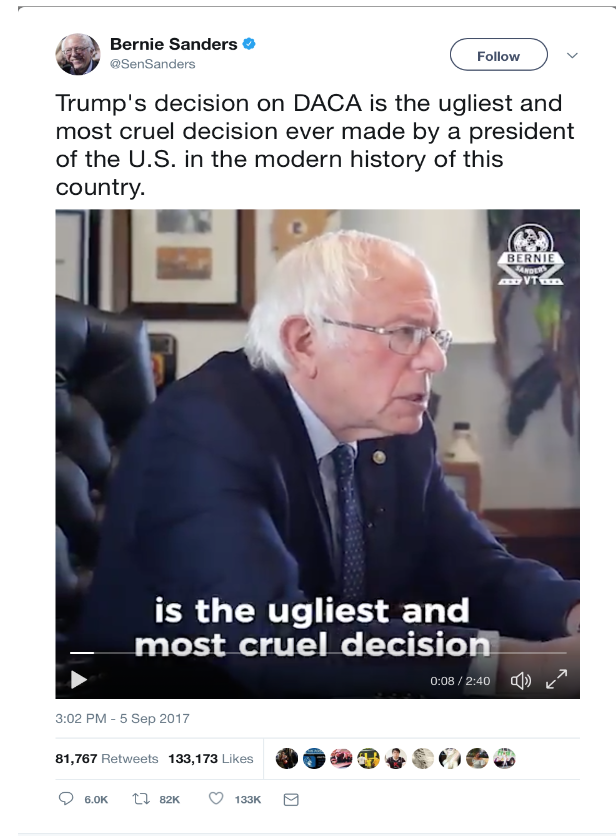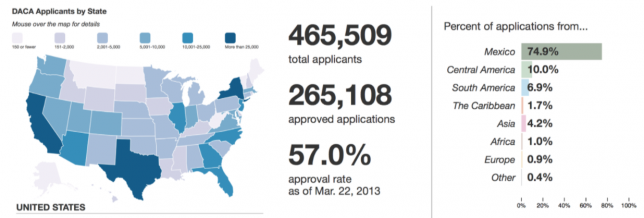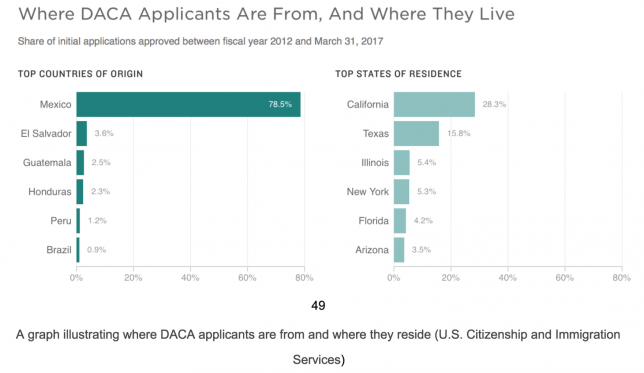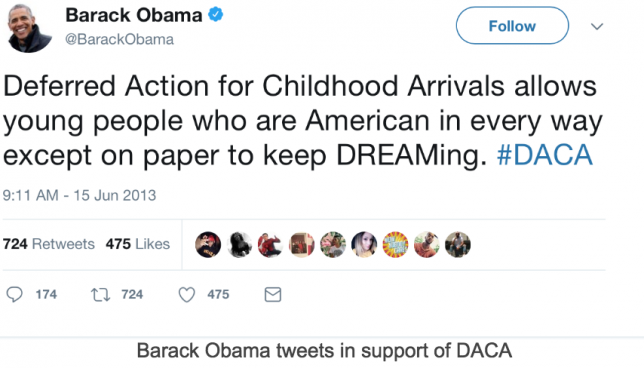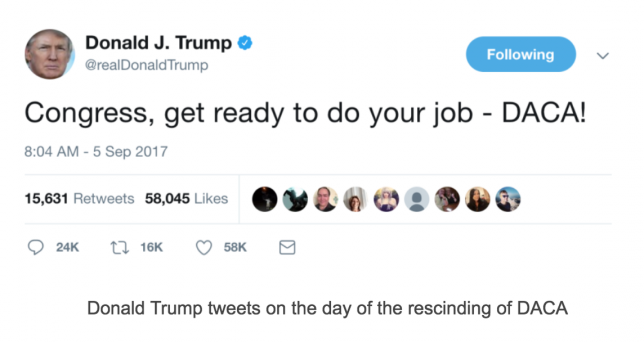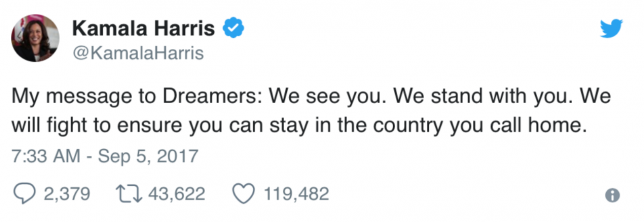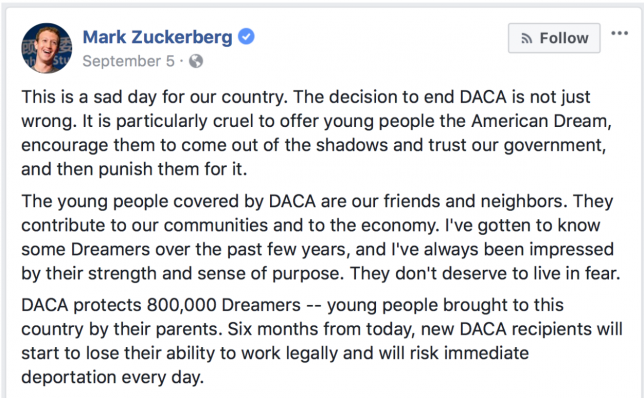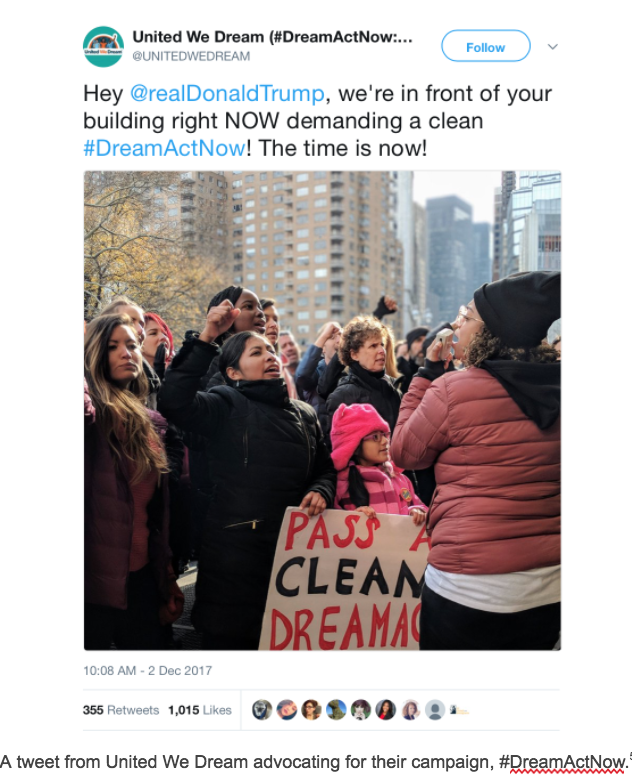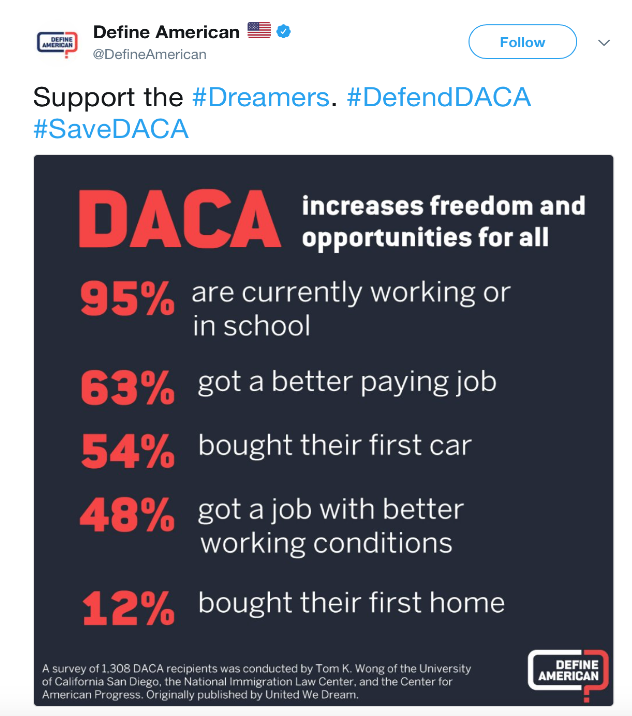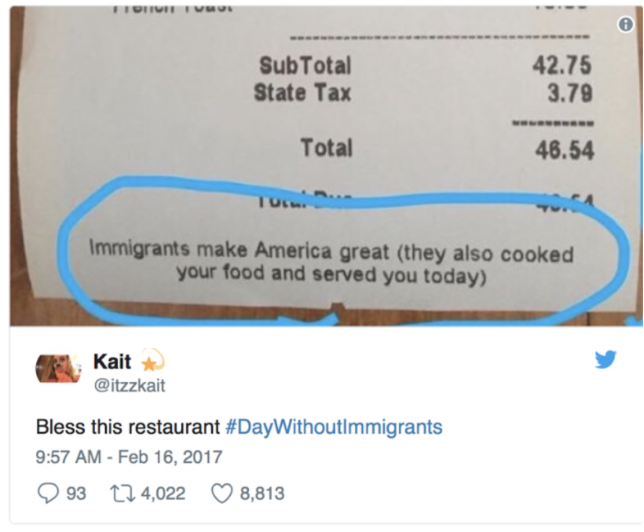PAGE NAVIGATION
- Introduction
- Context
- Key Actors
- Social Media Presence
- Offline Presence
- Impact of Movement
- Critiques of Movement
- Conclusion
Introduction
The “DREAMers” became prominent beginning in 2000, when more than one million children and youths found themselves in a similar situation with their shared immigration status. They had migrated to the United States as children without any authorization and grew up without legal status. As young adults, they faced similar challenges when trying to achieve their dreams and aspirations, thus spurring the Dream Act.
Before the Dream Act was proposed, the California Assembly Bill 540 was signed. This bill would allow undocumented students who met specific requirements to pay in-state tuition instead of out-of-state tuition.[1] This was a start for undocumented students in their educational careers, but life in the United States post graduating remained unsecure. In 2001, the Dream Act was introduced in Congress, and if passed, would have provided legal status and eligibility for citizenship. This initiated the difficulties of young, undocumented immigrants and their involvement with political action online and offline. It also heightened the emergence of the DREAMers[2], whose immediate goal was to pressure the Senate to support the Development, Relief, and Education for Alien Minors Act (DREAM Act) but ultimately, they were asserting their “right to have rights” as undocumented immigrants in the United States[3]. The term, Dreamer, was actually used long before the DREAM Act was introduced in 2001. Immediately after the act’s introduction, the youth popularized the new understanding of the word in online forums and media.[4][5]They began to use social media to their advantage as they participated in protests, rallies and campaigns to advocate for their rights.
Although the Dream Act never passed, DACA (Deferred Action for Childhood Arrivals) was established by the Obama administration in 2012, allowing individuals who entered the country illegally as minors to receive a renewable two-year period of protection from deportation and eligibility for a work permit. DACA provided the Dreamer movement with an opportunity for greater recognition and legitimacy.
The #DREAMers movement works in relation to politics, constantly urging political figures to support immigration reforms. It focuses on social issues relating to immigration and minority rights and, at-large, reflects on the effects of grassroots movements. Although the movement predates social media, it distinguishes itself by using techniques with an online and offline presence, used simultaneously at times. Ultimately, the presence of social media quickened the pace of the movement and extended it to a wider audience. Indeed, this movement existed before social media and would have still continued to exist without it, but it arguably may not have been as successful.
Context
Timeline of Key Events for #DREAMers Movement
SOCIAL MEDIA REACTIONS AND PROTESTS
December 28, 2017
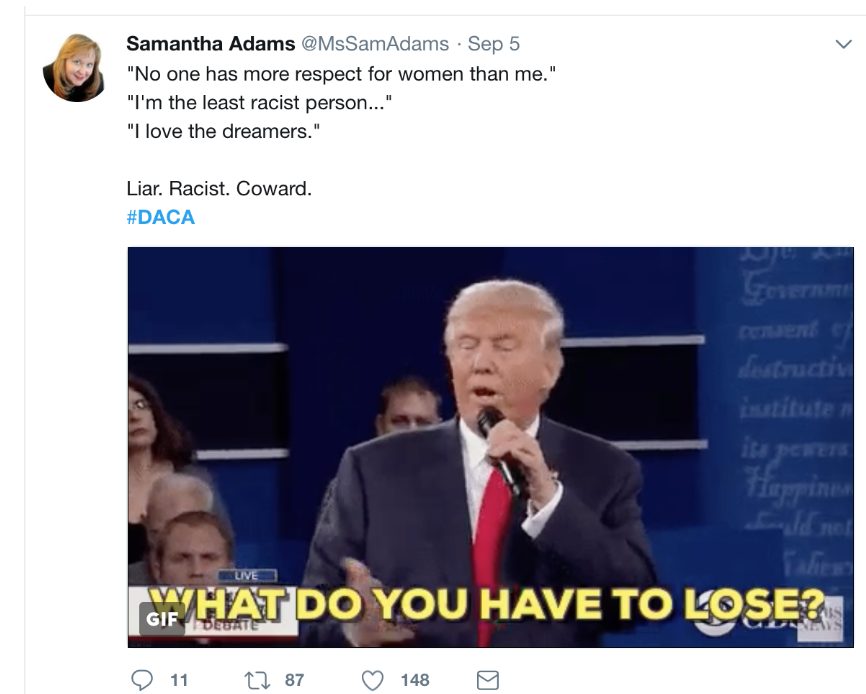
The termination of DACA ignited the public’s opposition to the administration. According to Talkwalker, a social data intelligence company, after one hour of Attorney General Jeff Sessions’…
Read moreDACA RESCINDED BY PRESIDENT TRUMP
September 5, 2017
Beginning in 2017, in his executive order, Trump removed privacy protections for DACA recipients and exposed their information to ICE agents. On June 16, 2017, the Department…
Read moreDACA SIGNED BY PRESIDENT OBAMA
November 20, 2014
In November 2014, President Obama announced his intention to expand DACA in order to take care of additional undocumented immigrants. However, twenty-six states filed a lawsuit…
Read moreJOSE ANTONIO VARGAS TIME MAGAZINE
June 25, 2012
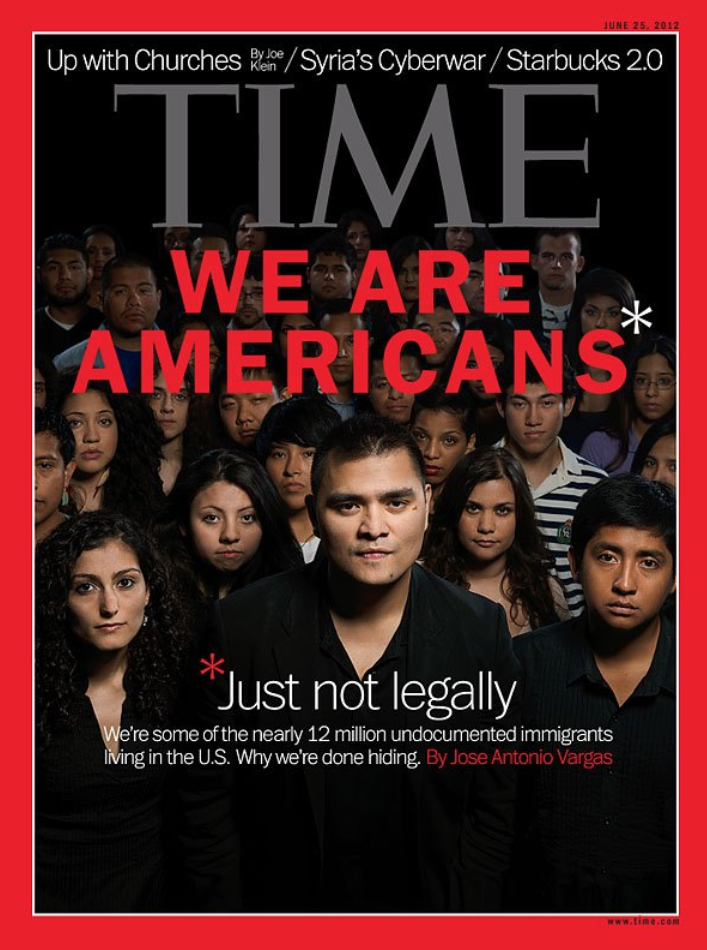
(Photograph by Gian Paul Lozza for TIME) Jose Antonio Vargas’s TIME Magazine Cover In June of 2012, Jose Antonio Vargas published a cover essay in…
Read moreDACA SIGNED BY PRESIDENT OBAMA
June 15, 2012

While being unable to find a legitimate remedy to protect children who were brought to the U.S. through no fault of their own, in 2008,…
Read moreSENATE BLOCKS DREAM ACT BILL
December 18, 2010
On December 18th, 2010, the latest version of the DREAM Act was introduced but failed to garner the 60 votes it needed to end a…
Read moreTRAIL OF DREAMS
January 1, 2010

On January 1, 2010, four students left Miami, Florida to embark on a 1,500-mile journey to Washington, D.C. to support the passing of the DREAM…
Read moreDREAM ACT REVIVED
September 1, 2007
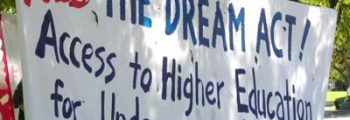
The DREAM Act, which previously fell victim to filibusters and considerable stalling, was revived in 2007 under the Comprehensive Immigration Reform Act or the Secure Borders,…
Read moreTHE DREAM ACT PROPOSAL
August 1, 2001
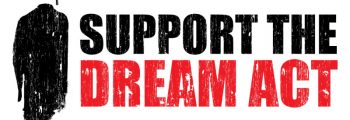
Prior to 2001, universities and other educational institutions, as well as military, business recruiters called on Congress to pass a legal act, so that more…
Read moreThe Dream Act Proposal → 2001
Prior to 2001, universities and other education institutions, as well as military, business recruiters called on Congress to pass a legal act, so that more and more eligible young children “with good moral character” that were brought to the U.S. illegally could stay in the country. [6] Thus, in order to resolve the children’s immigration status, the DREAM Act (Development, Relief, Education for Alien Minors) was proposed by Republican Senator Orrin Hatch of Utah and Senator Maria Cantwell on August 1st, 2001, with 6 co-sponsors. The purpose of the DREAM Act was meant to provide immigrants who entered the U.S. in their childhood with a path to citizenship.[7] In order to qualify for the DREAM Act, one must be under 35 years old with no criminal record, and be enrolled or have graduated from a university, or had served in the army. The DREAM Act provided various opportunities for undocumented immigrant youths to contribute back to the country. However, the DREAM Act eventually failed to get the necessary votes as it stalled in Congress and did not pass[8].
Dream Act Revived → 2007
The DREAM Act, which previously fell victim to filibusters and considerable stalling, was revived in 2007 under the Comprehensive Immigration Reform Act or the Secure Borders, Economic Opportunity and Immigration Reform Act. This new bill as the name implies was going to be more extensive and complete. The act, however, had a similar fate as it did in 2001 and failed with a passing cloturemotion.5
Senate Blocks Dream Act Bill → 2010
On December 18th, 2010, the latest version of the DREAM Act was introduced but failed to garner the 60 votes it needed to end a GOP filibuster. Although the House had voted in favor of the measure (216-198) a week earlier, the Senate republicans blocked this measure by a vote of 55-41. The measure was last brought to the Senate floor in 2007, hereby marking its second defeat. Republicans who opposed this measure expressed their concerns with the bill, stating it rewards criminal behavior, is costly for taxpayers, and also spurs further illegal immigration. President Obama expressed his disappointment in the result, stating that “common sense” did not prevail. President Obama did, however, vouch to continue to fight for the DREAM act and promised that his administration would not give up on it.[9] Many saw the Senate vote in 2010 as a frantic last effort by Democrats to pass the bill before Republicans would inevitably gain possession of the House and win seats in the Senate by January. This last vote essentially signified a closing window for the passage of the measure.[10]
Trail of Dreams → 2010
On January 1, 2010, four students left Miami, Florida to embark on a 1,500-mile journey to Washington, D.C. to support the passing of the DREAM Act. The students were brought to the U.S. illegally when they were children. They stated, “this is the only country we have known as home.”[11] Once they reached their endpoint, they requested a meeting with President Barack Obama. This goal was not met by the end of the walk. The youth documented their walk with active blogging on Facebook, Youtube and Twitter and garnered 30,000 signatures throughout their journey.[12] The press referred to the student walkers as “DREAMers” or “Dream Walkers.”

 [13] The first tweet from the Trail of Dreams Twitter account used to document the 1,500-mile walk.
[13] The first tweet from the Trail of Dreams Twitter account used to document the 1,500-mile walk.
Jose Antonio Vargas Time Magazine → 2012
In June of 2012, Jose Antonio Vargas published a cover essay in the New York Times which proved to be momentous for the Dreamers movement. Vargas, a Pulitzer prize winning journalist who was born in the Philippines and raised in Mountain View, “came out” as being an undocumented immigrant. Vargas was inspired to write this essay after he heard of the “Trail of Dreams”. After taking his story to the national stage, Vargas shifted from mainstream journalist to immigrant rights advocate and started his own organization called “Define American” while also increasing his leadership and involvement in the DREAMers movement.[14] Vargas wrote: “On the surface, I’ve created a good life. I’ve lived the American dream… But I am still an undocumented immigrant. And that means living a different kind of reality. It means going about my day in fear of being found out. It means rarely trusting people, even those closest to me, with who I really am…And it has meant relying on a sort of 21st-century underground railroad of supporters, people who took an interest in my future and took risks for me.”[15]
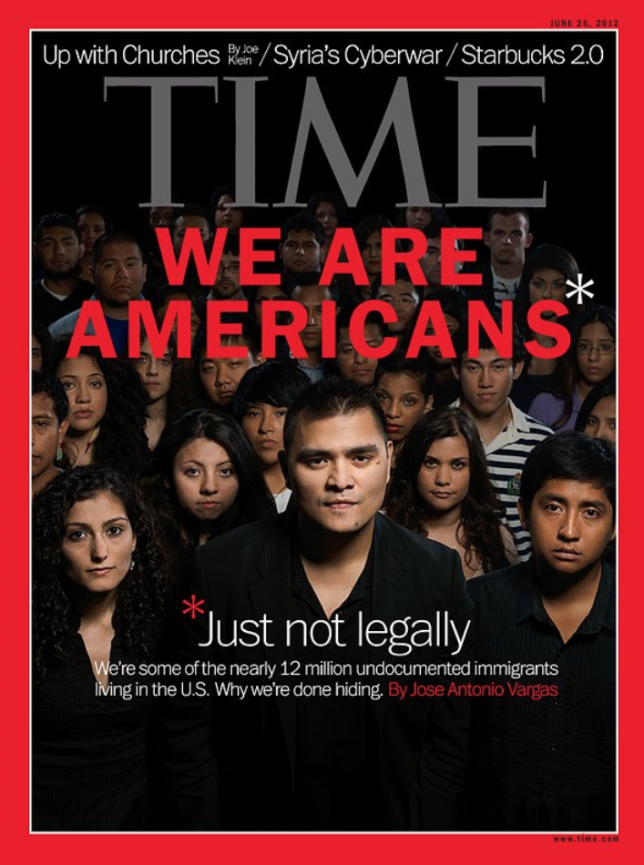
(Photograph by Gian Paul Lozza for TIME)
Jose Antonio Vargas’s TIME Magazine Cover
DACA Signed by President Obama → June 2012 – September 2017
While being unable to find a legitimate remedy to protect children who were brought to the U.S. through no fault of their own, in 2008, the Obama Administration announced Obama’s decision to impend Deferred Action for Childhood Arrivals. [16] On June 15, 2012, President Barack Obama announced DACA with a speech in the Rose Garden of the White House. [17] The policy allowed certain immigrants to be excluded from deportation and obtain work permits for a period of two years, and it’s also renewable if the individual maintains good behavior.[18] In November 2014, President Obama announced his intention to expand DACA in order to take care of additional undocumented immigrants. However, twenty-six states filed a lawsuit challenging the expansion of DACA under the argument that he violated his constitutional duty to enforce the laws and illegally placed new burdens on state budgets.[19] [20] Thus, the expansion of DACA was placed on a hold.
DACA Rescinded by President Trump → September 2017
Beginning in 2017, in his executive order, Trump removed privacy protections for DACA recipients and exposed their information to ICE agents. On June 16, 2017, the Department of Homeland Security announced their intention to repeal the expansion of the DACA Program. However, the overall existence of DACA would still be under review.[21] On September 5, 2017, Attorney General Jeff Sessions announced to the public that the DACA program is being repealed. He also mentioned that those who are eligible for DACA are in fact lawbreakers, and impacted the employment of local Americans.[22] According to the new policy, “people whose work authorizations will expire by March 5, 2018 – six months from the announcement – can apply for two-year renewals until October 5. DHS will continue to adjudicate already-filed DACA initial requests on a case-by-case basis. It will no longer issue new advance parole documents to DACA recipients.”[23] On the same day, President Trump also released to the press a statement claiming that “the DACA program was going beyond President Obama’s constitutional responsibilities.”[24] However, those DACA recipients wouldn’t be deported abruptly, since the administration wouldn’t move against those recipients for six months.
Social Media Reactions and Protests → September 2017 – Present
The termination of DACA ignited the public’s opposition to the administration. According to Talkwalker, a social data intelligence company, after one hour of Attorney General Jeff Sessions’ announcement (12 noon to 1 p.m. EDT), more than 487,000 social media posts mentioned DACA; in the period between midnight and 1:30 p.m., more than 1.3 million posts mentioned DACA.[25]
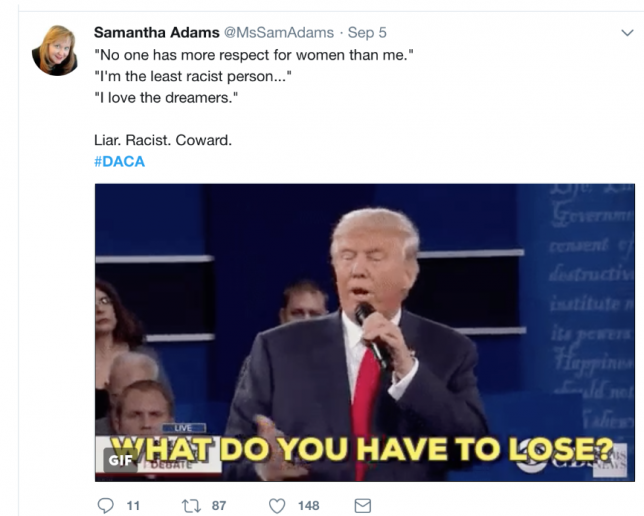

A tweet from a social media user negatively reacting to Trump’s rescinding of DACA

[27]Google Trend graph representing the search interest of the term “DACA” for the United States 
A tweet from Bernie Sanders in response to Trump’s decision to rescind DACA
Social media platforms become one of the largest stages for opponents to express their anger. A tweet by Bernie Sanders about the termination of DACA went viral, receiving 82K retweets and 133K likes.. Bernie Sanders calls it the “ugliest and most cruel decision ever made by a president of the US in the modern history of this country.[29]”
Inflection Points: #DREAMers

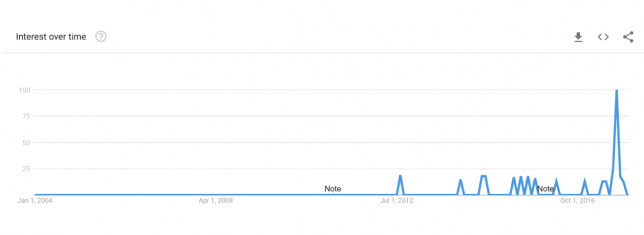
[30] A Google Trend graph representing the interest over time in #DREAMers and its inflection points
There are a few inflection points that correlate directly to events that occurred throughout the movement’s history. In 2010, a spike in searches occurs which corresponds to the Dream Act entering the Senate and ultimately being blocked by Republicans. In 2011, we see a second spike which occurs at around the same time that Jose Antonio Vargas publishes his New York Times article which led to a big step forward for the Dreamers movement. After 2011, we see a steady amount searches which meant the movement remained relevant for several years. Finally, we see a major spike and one that surpasses the first two which occurs directly after President Trump announced his decision to rescind DACA.
Political spectrum location/affiliation
Before the modern immigration movement of the DREAMers came about, undocumented youths as a political group did not exist. This is due mainly because undocumented immigrants were afraid to “come out” with their illegal status in fear of being oppressed or, at worst, deported. Their first encounter with politics came about when the Dream Act was proposed in 2001. The group of young, undocumented immigrants took part in a decade-long campaign filled with mass mobilizations, lobbying, teach-ins, rallies and civil disobedience actions.[31] For instance, activists scheduled a sit-in at Senator McCain’s Arizona office calling for an end to the criminalization of immigrants and the passage of the Dream Act. Months later, undocumented students in Georgia risked deportation by protesting at a downtown intersection in an act of civil disobedience.[32] For the Dreamers, risking deportation became a political strategy and was the initial cornerstone for the movement.
Demographics
As mentioned in the beginning of the chapter, DREAMers refers to the young, undocumented immigrants currently in the United States who are also eligible for DACA.[45]
As analysis shows, most DREAMers are Mexican and they reside in big immigrant-receiving states with a large number of undocumented populations. These states include California and Texas. [46] More than half of the DREAMers are between the age of 15 and 30. Around 20 percent of the DREAMers are 5-14 years old, and another 20 percent are 15-30 years old but have to complete GED (General Educational Development) in order to be eligible for DACA.
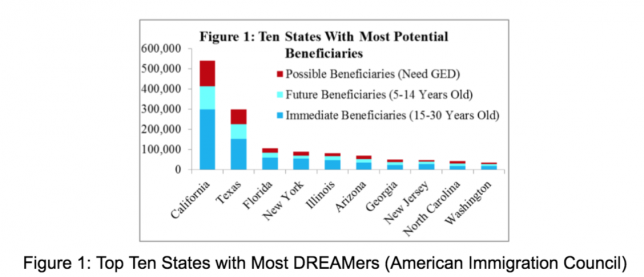
Figure 1: Top Ten States with Most DREAMers (American Immigration Council)
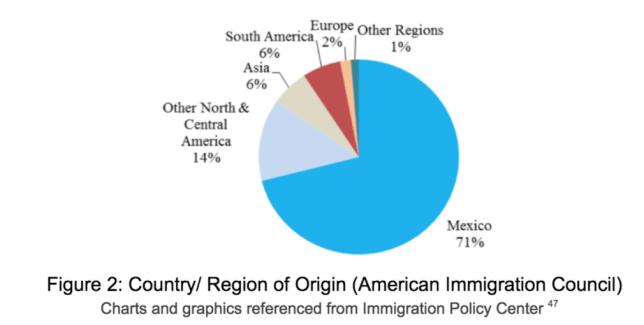
Figure 2: Country/ Region of Origin (American Immigration Council)
Charts and graphics referenced from Immigration Policy Center [47]
Before Trump rescinded the DACA program, the DREAMers were also eligible to apply. Similar to the demographics of the DREAmers, most of the DACA applicants are from Mexico, and their top two states of residence are California and Texas.
A graph illustrating DACA applicants by state (Brookings FOIA data)
A graph illustrating where DACA applicants are from and where they reside (U.S. Citizenship and Immigration Services)
Key Actors
Jose Antonio Vargas
Jose Antonio Vargas played an influential role in the Dreamers movement. In 2011, he wrote an essay for The New York Times Sunday Magazine in which he revealed his status as an undocumented immigrant. This essay received an enormous amount of media attention. Vargas continued to fight for immigration rights and founded the non-profit organization, Define American. He began to track the use of the term “illegal immigrant” in the media, hoping to influence society to begin using “undocumented” instead. In effect, news outlets, such as the Associated Press, announced that they would no longer use the phrase in their articles. Vargas continued to remain active on immigration rights, working closely with the tech community and Silicon Valley to advocate for immigration reform. In July 2015, Vargas directed and starred in a documentary that aired on MTV called White People, which focused on the concept of white privilege.[37]
[38]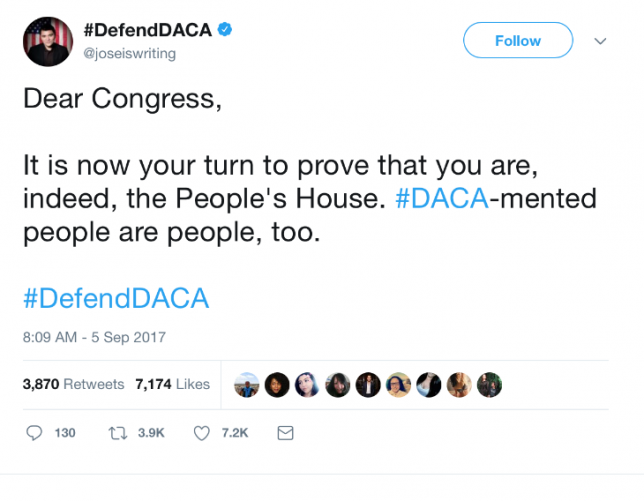
Jose Antonio Vargas tweeted in response to the rescinding of DACA
Barack Obama
Former president, Barack Obama, played a key role in the movement of the Dreamers. In his 2008 campaign, Obama promised to reform America’s immigration system. While he failed to have a comprehensive immigration reform law passed, he took significant steps in protecting Dreamers and focused on enforcement priorities. In June 2012, Obama made an executive decision to initiate DACA.
Barack Obama tweets in support of DACA
Donald Trump
Due to the fact that DACA allows large numbers of young undocumented adults to remain in the United States without the fear of deportation, Trump Administration has been planning to to resign the five-year-old policy. [40] Trump denounced the DACA Policy, stating that DACA helped ignite a large increase of immigrants, most of whom are from Central America.[41]
On September 5th, 2017, President Trump announced the change at the Justice Department, claiming that DACA applicants are lawbreakers and will harm native-born Americans in employment, income and other opportunities. Furthermore, Trump Administration claimed that the DACA Program is in fact unconstitutional. [42]
The reason of this action, as President Trump stated, was concern for the native-born American Citizens by this “unfair” program. In fact, Trump made his move seem more compassionate; otherwise, the resignation of DACA would have been enforced immediately and would have been highly disruptive, according to White House officials. [43]
Donald Trump tweets on the day of the rescinding of DACA
Celebrity endorsers
Many celebrities have spoken on social media platforms in response to Dreamers and the removal of DACA by President Trump.
Celebrities of different entertainment disciples have spoken about the issue, including, but not limited to, Kamala Harris, Khloe Kardashian, Cher, Gina Rodriguez, and Diddy. Many of the comments shamed Trump and his decision to remove DACA and stand with the Dreamers.
Tweet from Senator, Kamala Harris, showing her solidarity with the Dreamers after the rescinding of DACA
Facebook post by Mark Zuckerberg addressing his solidarity with the Dreamers after the rescinding of DACA
In addition, Mark Zuckerberg, along with Bill Gates sent an open letter to the public via FWD.us, urging the congress to pass a similar legislation to the DREAM Act that grants the DREAMers the rights they have been advocating for.[60] The letter was also co-signed by over 800 leaders from tech companies[61]. The letter was sent right after President Trump announced the ending of DACA[62].
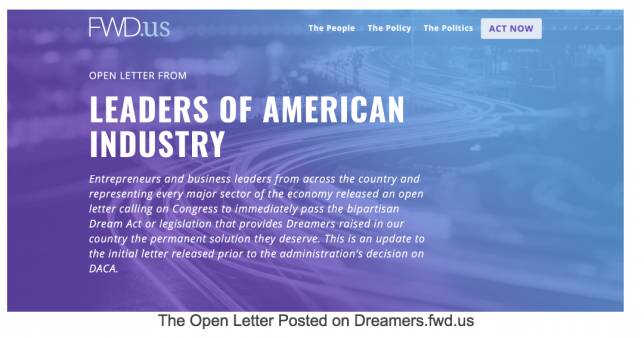

The Open Letter Posted on Dreamers.fwd.us
Organizations
United We Dream
Many organizations exist in an effort to provide a platform for young, undocumented immigrants to have voices. One of the largest and earliest organizations is United We Dream, a youth-led immigrant activist umbrella organization, which was formed in response to the media coverage that circulated around that time[50]. United We Dream began in the mid-2000s, when it was founded by Cristina Jimenez to promote equal educational opportunities for youth immigrants. Together, they have coordinated a series of events to push for the passage of the Dream Act. Since then, United We Dream has grown to become the largest immigrant youth-led activist group, with more than 100,000 members and 55 affiliate organizations in 26 states. Recently, they have initiated a campaign using the hashtag, #DreamActNow, gathering hundreds of people from Texas and across the country to advocate for a “clean” Dream Act.[51]
A tweet from United We Dream advocating for their campaign, #DreamActNow.[52]
Define American
Another organization that focused on the stories of undocumented immigrants is Define American, a group founded in 2011 by Jose Antonio Vargas. According to its website, Define American is a media and culture organization that uses “the power of stories to transcend politics and shift the conversation around immigrants, identity and citizenship in a changing America.”[53] They claim to challenge, create and curate media by starting various campaigns, such as #FactsMatter and #WordsMatter. With the help of hashtags, this organization has brought awareness to the public in understanding the Dreamers movements and their fight for their rights as American citizens.
A tweet from Define American calling for the help of supporters to support DACA before it was terminated.
FWD.us
FWD.us is an organization founded by Joe Green and Mark Zuckerberg on April 11, 2013 to advocate for immigration reform. The founders aim to repair the broken immigration system in the United States. [55] Founders, Green and Zuckerberg, believe that such an organization will mobilize the tech community and support the immigrant’s rights.[56]
FWD.us provides support for the immigrant community by providing social services, giving out scholarships, as well as emphasizing online advocacy.[57] Moreover, on September 20th, 2017, FWD.us united more than 800 tech company leaders and signed an open letter to the public, addressing immigrant’s right. FWD.us has also initiated a campaign named “PUSH4REFORM”. The campaign also aims to support the immigrant community, by connecting individual immigrants to Congress members and push the Congress to pass DREAM-Act-like legislations.
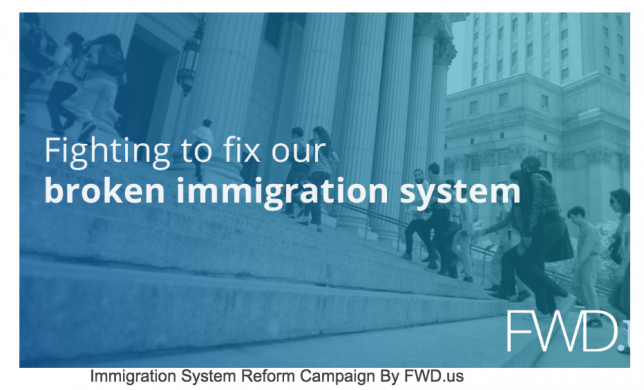
Immigration System Reform Campaign By FWD.us
Social Media Presence
The Dreamers movement first began when social media was not widely utilized. However, as social media gained popularity the movement also began to use various social media platforms. Some of which were more typical such as Facebook, Twitter, and Instagram, where each were utilized as a means to congregate and plan various events which included protests. These platforms were also used to post and circulate various opinions around the issue. Gofundme was one of the more non-traditional platforms that was used to support the movement. Gofundme, a crowd-funding and fundraising website was employed to raise money in support of DACA recipients and also for organizations. Conducting a quick search on gofundme showed that there 4766 fundraisers relating to #DREAMers and 1124 relating to DACA.[63] This simply shows how widely used the platform has been.
Facebook has primarily been used to share personal narratives and to also organize events. There are two main Facebook pages that have a substantial following and who have been the most active. UndocuMedia is one of the pages and has 235,154 likes and 241,013 followers.[64] The about section states that “UndocuMedia leverages digital and social media to empower the undocumented community throughout the US. We are online and on-the-ground grassroots organizers who help the community stay informed and fight for social justice.” As of March 2015, UndocuMedia became a 501(c)3 nonprofit organization and is recognized across the nation as a credible source for the latest news and other issues affecting immigrant communities. [65] Another prominent page belongs to the United We Dream organization. Their page has 137,126 likes 138,293 followers. The United We Dream Facebook page is primarily used to post relevant news stories pertaining to immigrant communities and also to organize events such as protests.
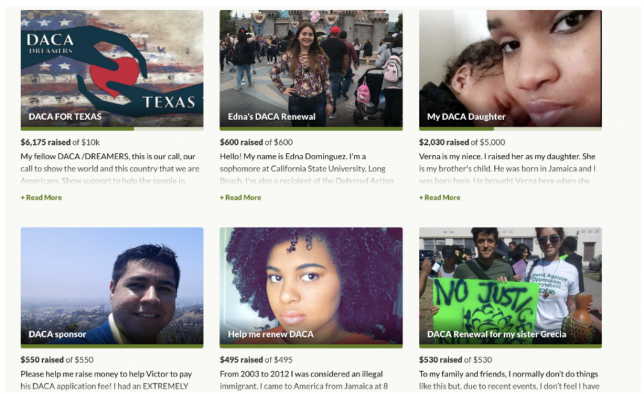
Results from the search “DACA” on GoFundme.com[66]
Popular Hashtags
#DREAMers
One of the most popular and consistent hashtags on social media that has been used in the movement is #DREAMers[67]. DREAM is originally the acronym for the Development, Relief, and Education for Alien Minors Act. #DREAMers became popular on social media around June, 2011, when Jose Antonio Vargas revealed his undocumented status in New York Times.[68] The hashtag stays popular until now, and it is used for Dreamers to stand together and share their stories to the world.
#DACA
#DACA became popular when Trump rescinded the DACA program in September, 2017. Due to Trump Administration’s decision, more than a million undocumented youths are now at the risk of being deported from the United States. [69] Those affected young children didn’t stay silent. Instead, they spoke out on popular social media platforms to call people’s attention. #DACA united those DACA applicants and recipients and let them stand together to protect the DACA program.
In addition, several other hashtags are associated with #DACA including #withDACA and #DefendDACA.
Social media users using the hashtags #WithDACA and #HereToStay (Left Tweet No Longer Available)[71]

New York State Attorney General, Eric Schneiderman urging to defend DACA using hashtags #DefendDACA and #DREAMActNow.
#HereToStay
#HereToStay is closely related to #DREAMers and the end of DACA. Same as #DACA, after the Trump Administration announced to end DACA, the hashtag trended across social media platforms like Facebook, Twitter and Instagram.[73] Americans use this hashtag to share their immigrant stories and experiences to stand united and protect all Dreamers. The hashtag has several spikes on social media when Trump became president, and when Trump announced the end of DACA. [74]
#FactsMatter
#FactsMatter is another popular hashtag that has circulated social media. According to Define American, issues surrounding immigration are often the least fact-checked and consequently the least understood. This hashtag was created to put an end to stories that lack accurate statistical perspectives which are generated to instill fear.[75]
#WordsMatter
#WordsMatter is a hashtag that has been utilized in the #DREAMers movement to generate a better understanding of how the use of certain words can affect how we understand the world. For instance, the use of “illegal immigrant” or “illegal alien” forgo complex legal cases with the direct assumption of guilt. These terms inherently criminalize a undocumented individual’s personal identity. Define American explains that being undocumented in the United States is a civil offense and not a criminal one. Terms such “undocumented” and “unauthorized” are alternative terms that offer a more neutral perspective.[76]
Meme vs. Cause
The DREAMers movement has been largely cause-based. However, it does uphold a meme culture that, although may not be as apparent as other movements, still provides a witty aspect that intensifies the argument of the Dreamers. The memes of this movement are largely used to display the idiocracy of political figures, but ultimately make light of a bitter situation. In a sense, the meme culture has erased the stigma held by society towards the Dreamers and humanized the peaceful movement with comedic posts.
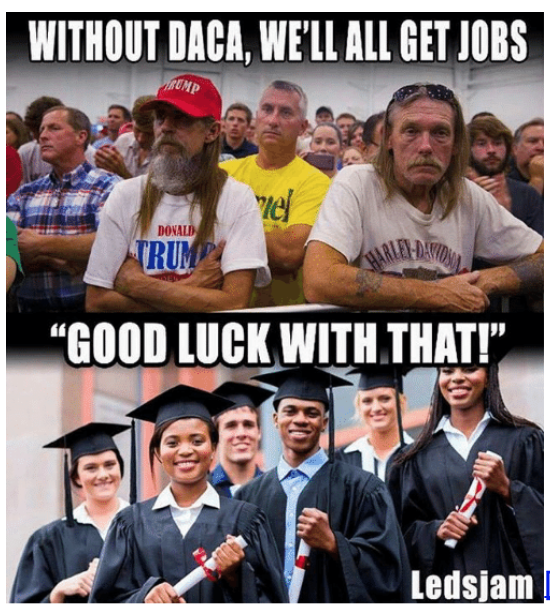
A meme created to mock an argument against DACA (Ledsjam)
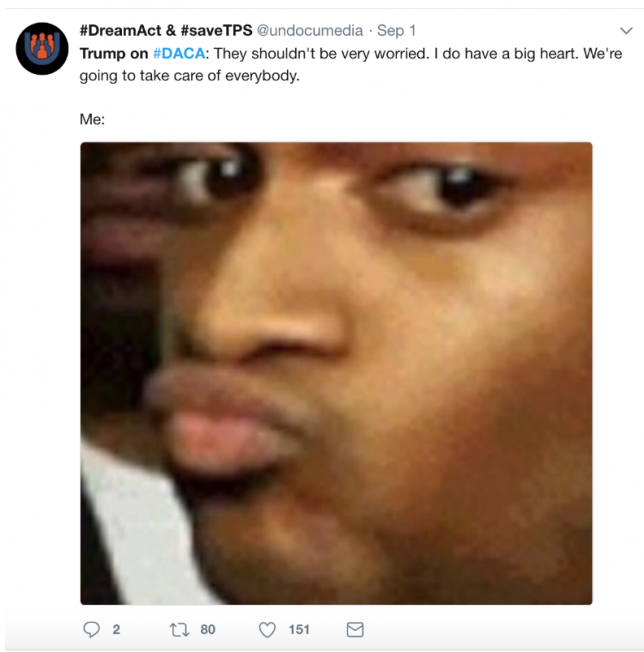
 [78]
[78]
A tweet from Undocumedia mocking Trump, using a meme to add comedic value.
Offline Presence
The #Dreamers movement predated social media, garnering a strong offline presence since 2001. The protest that memorializes the DREAMers Movement is the “Trail of Dreams,” a 1500-mile journey, held in 2010 and created by four students, that began in Miami, Florida and ended in Washington D.C. to promote human rights, stop the deportations of current undocumented students and to support the Dream Act. The Dreamers used a variety of methods to promote immigration reforms, such as holding press conferences and acts of peaceful civil disobedience, calling and emailing members of Congress, lobbying, and signed petitions.They were able to gather over 30,000 signatures over the course of the 1500-mile journey. Their efforts were not ignored. In June 2010, one of the Dreamers was granted a meeting with former President Obama to discuss immigration reform.[33]
The Dreamers continued to push political figures to support immigration reforms. On September 20, 2010, a group of college students wearing caps and gowns held a sit-in at Senator John McCain’s Arizona office to persuade him to support the Dream Act. Four of the students were arrested for trespassing, three being undocumented. This triggered deportation proceedings but it was later dropped.[34]
Physical protests continue to take place to raise awareness of immigration rights. Earlier this year, immigrants across the U.S. did not go to work as part of the protest “A Day Without Immigrants.” The purpose was to show America what the country would look like without immigrant labor. Several restaurants printed messages of unity on customer receipts. However, not all employers showed sympathy for those who participated. A number of participants were fired in the fallout of the protest.[35]
Dreamers have risked their safety to fight to stay in the United States and they make it known through their physical protests, along with their online presence.
A tweet from a social media user praising a restaurant for supporting the “A Day Without Immigrants” protest
Organic vs. Planned Growth
Though the #DREAMers movement has organically exponentialized in conversation and in the media, it has been strategically planned from the start. After the Dream Act was introduced in 2001, a group of young, undocumented immigrants mobilized and created an organization. They had a common mission to push the Senate to support the Dream Act and ultimately pass the bill. Their protests were premeditated and they spoke publicly of their illegal status in order to gain the attention of political authorities and society. By doing so, they were able to get the attention of former president, Barack Obama, who went on to make the executive decision to initiate the DACA program.
Impact of Movement
There is speculation on whether or not the Dreamers have been successful in their movement. Although DACA was rescinded in 2017 by the Trump Administration, the Dreamers were successful in pushing Obama to take action in implementing the program using executive order. Furthermore, they have revolutionized the playing field for undocumented immigrants. Before the Dreamers came about, many young, undocumented immigrants were unable to speak of their illegal status in fear of deportation. The Dreamers changed that in which they gave people confidence to openly discuss the issue and raise awareness.
Critiques of Movement
The immigration rights movement has caused much controversy among society. For the Dreamers, the same critiques and concerns have been voiced. The largest concern is allowing people that could potentially be criminals or offenders of our country. For instance, opponents of DACA contend that DACA encouraged immigrants to enter the U.S., and some of the immigrants became members of dangerous gangs.
Jonathan Perez, an undocumented political exile from Chile and co-founder of the Immigrant Youth Coalition, criticized the name of the movement, stating that the term “Dreamers” became exclusively a term for those who served as model residents. In his eyes, the story of the Dreamer “served as a wedge between youth who qualify for the DREAM Act and the rest of the community who didn’t,” extending the exclusion to those who hold criminal records, prior deportations and people who did not fit the age requirements.[79] Further critiques describe the “coming out” aspect of the movement to be a privilege for a very select few of individuals. Primarily, very young and or highly qualified individuals with flawless records. Even simple offenses such as marijuana possession or DUIs are grounds for permanent expulsion. Furthermore, some explain that the substitution of the word “Undocumented” for “Illegal” does very little to remove the structures of illegality that still shape immigration and citizenship.[80]
Critiques from the right follow the narrative that DACA and the DREAM Act will only lead to more anchor babies. They discuss the “unpublicized” dangers of “illegal aliens” flowing across the US borders with their children in order to receive amnesty.[81]
Conclusion
The #DREAMers movement is a modern-day fight for immigration rights among the undocumented youth. It sets itself apart from other social movements for the reason that it predated social media, utilizing other forms of media to mobilize. The movement is heavily reliant on political affiliation, constantly pushing political figures to create and support legislative bills in support of immigration reforms.
Social media was not only vital in disseminating information about the DREAM Act but it was also crucial in bringing people together. Social media platforms facilitated the process of creating a collective voice for the movement. Groups and pages on the various social media platforms essentially created a sense of belonging for many undocumented immigrants which ultimately led to a stronger and more unified community. Furthermore, social media allowed the movement to spread information regarding the issues of immigration to the general public. Without these platforms, engagement with the public would have been severely limited. Although the Dreamers were not able to succeed in the passing of the DREAM Act and prevention of the rescinding of DACA, they succeeded in giving immigrants a voice to “come out” as undocumented. It is difficult to say whether or not the #DREAMers movement is fully successful because they remain fighting for their rights in the United States and the movement is very much continuing today.
Ultimately, the presence of social media expedited the pace of the movement and allowed it to reach out to a wider audience. It is arguable that, without social media, this movement may not have been as successful today.
Author Biographies:
Diana Dzhangiryan
I am a junior transfer in the Haas School of Business and I will be graduating in the Spring of 2019. I transferred from Pasadena City College in Southern California and have come to love the Bay Area since my move here. Aside from my interest in Business, I have an inherent passion for music.
Guowei Yang
I am a third year EECS major, and I transferred from East Los Angeles College in the year 2017. I took this class because I am a really big fan of social media, and this class really enriched my knowledge in social media and social movements in the United States. I will be graduating in 2018.
Logan Rinder
I’m an Anthropology Major with interests in social media and business. I transferred from San Diego Mesa College in the Spring of 2017 and will be graduating in 2018. I’m passionate about sports, travel, and good food.
[1] “AB 540 Dreamers – Foothill College”. AB 540 Dreamers. Retrieved 2017-12-04.
[2] Lobdell, Terri. “The Dreamer Social Movement.” Palo Alto Online, Palo Alto Weekly, 12 Feb. 2016, paloaltoonline.com/news/2016/02/12/the-dreamer-social-movement.
[3] Nicholls, Walter J. The DREAMers: How the Undocumented Youth Movement Transformed the Immigrant Rights Debate. Stanford University Press, 2013.
[4] “Immigrating to Canada [Archive] – DREAM Act Portal Forum”. dreamact.info. Retrieved 2017-12-04.
[5] Rivas, Jorge. “Why You Should Stop Using the Term DREAMer”. Splinter. Retrieved 2017-12-04.
[6]“5 Reasons to Support the DREAM Act – America’s Voice”. America’s Voice. 2010-09-15. Retrieved 2017-12-04.
[7] “DREAMers and DACA – Deferred Action for Childhood Arrivals | CAIRCO – Colorado Alliance for Immigration Reform | issues legislation projects research”. CAIRCO – Colorado Alliance for Immigration Reform. Retrieved 2017-12-04.
[8] “A Timeline On DACA”. The Odyssey Online. 2017-09-07. Retrieved 2017-12-04.
[9] Herszenhorn, David M. “Senate Blocks Bill for Young Illegal Immigrants.” The New York Times , 18 Dec. 2010, www.nytimes.com/2010/12/19/us/politics/19immig.html.
[10] Dwyer, Devin, and Matthew Jaffe. “Senate Republicans Block DREAM Act for Illegal Immigrants.” Abc News, 18 Dec. 2010, abcnews.go.com/Politics/dream-act-senate-republicans-block-act-for-illegal-immigrant-students/story?id=12429589.
[11] “trail2010.org : About”. trail2010.org. Retrieved 2017-12-03.
[12]“A Dream Detained: Undocumented Latino Youth and the DREAM Movement”. NACLA. Retrieved 2017-12-03.
[13] https://twitter.com/Trail2010/status/7286899097
[14] Lobdell, Terri. “The Dreamer Social Movement.” Palo Alto Online, Palo Alto Weekly, 12 Feb. 2016, paloaltoonline.com/news/2016/02/12/the-dreamer-social-movement.
[15] Vargas, Jose Antonio. “My Life as an Undocumented Immigrant.” The New York Times, The New York Times, 22 June 2011, www.nytimes.com/2011/06/26/magazine/my-life-as-an-undocumented-immigrant.html.
[16]“5 Questions About DACA Answered”. NPR.org. Retrieved 2017-12-04.
[17] “Remarks by the President on Immigration”. whitehouse.gov. 2012-06-15. Retrieved 2017-12-04.
[18] Jeffrey S. Passel and Mark Hugo Lopez (August 14, 2012). “Up to 1.7 million illegal immigrant youth may benefit from new deportation rules”. Pew Research Center. Retrieved November 21, 2014.
[19]“4 Reasons Why States Suing to Stop Immigration Actions Stand to Lose Big – Center for American Progress”.Center for American Progress. 2016-03-28. Retrieved 2017-12-04.
[20] Montgomery, David; Preston, Julia (2014-12-03). “17 States Suing on Immigration”. The New York Times.ISSN 0362-4331. Retrieved 2017-12-04.
[21] Hesson, Ted (June 16, 2017). “DACA still ‘under review,’ Trump administration says”. Politico. Retrieved June 17, 2017. https://www.politico.com/story/2017/06/16/trump-daca-immigration-deportation-relief-program-239654
[22] Shear, Michael D.; Davis, Julie Hirschfeld (September 5, 2017). “Trump Moves to End DACA and Calls on Congress to Act”. The New York Times. ISSN 0362-4331. Retrieved September 6, 2017.
[23]“Senate Republican Policy Committee”. www.rpc.senate.gov. Retrieved 2017-12-04.
[24]Swanson, Ian (2017-09-05). “Trump rescinding DACA program”. TheHill. Retrieved 2017-12-04.
[25]Bureau, INQUIRER.net US. “DACA termination lights up social media | INQUIRER.net”. usa.inquirer.net. Retrieved 2017-12-04.
[26] https://twitter.com/MsSamAdams/status/905095294618132481
[27] <script type=”text/javascript” src=”https://ssl.gstatic.com/trends_nrtr/1225_RC05/embed_loader.js”></script> <script type=”text/javascript”> trends.embed.renderExploreWidget(“TIMESERIES”, {“comparisonItem”:[{“keyword”:”daca”,”geo”:”US”,”time”:”today 12-m”}],”category”:0,”property”:””}, {“exploreQuery”:”geo=US&q=daca&date=today 12-m”,”guestPath”:”https://trends.google.com:443/trends/embed/”}); </script>
[28] https://twitter.com/SenSanders/status/905189327218638853
[29] https://twitter.com/SenSanders/status/905189327218638853
[30] <script type=”text/javascript” src=”https://ssl.gstatic.com/trends_nrtr/1225_RC05/embed_loader.js”></script> <script type=”text/javascript”> trends.embed.renderExploreWidget(“TIMESERIES”, {“comparisonItem”:[{“keyword”:”#DREAMers”,”geo”:”US”,”time”:”2004-01-01 2017-12-05″}],”category”:0,”property”:””}, {“exploreQuery”:”date=2004-01-01 2017-12-05&geo=US&q=%23DREAMers”,”guestPath”:”https://trends.google.com:443/trends/embed/”}); </script>
[31]Negron-Gonzales, Genevieve. “Undocumented, unafraid and unapologetic: Re-articulatory practices and migrant youth “illegality””. Latino Studies.
[32]Negron-Gonzales, G. “Undocumented, Unafraid and Unapologetic: Re-Articulatory Practices and Migrant Youth.” Latino Studies.
[33] Montgomery, David. “Trail of Dream Students Walk 1,500 Miles to Bring Immigration Message to Washington.” The Washington Post, WP Company, 1 May 2010.
[34]Preston, Julia. “Illegal Immigrant Students Protest at McCain Office.” The New York Times, The New York Times, 17 May 2010.
[35]Lam, Bourree. “A Strike to Show What America Is Like Without Immigrant Workers.” The Atlantic, Atlantic Media Company, 16 Feb. 2017, www.theatlantic.com/business/archive/2017/02/day-without-immigrants/516969/.
[36] https://twitter.com/itzzkait/status/832287868378824707
[37]Johnson, Host: Joshua. “New Documentary Examines the Role of ‘White People’ in Race Dialogue.” Forum, ww2.kqed.org/forum/2015/07/24/new-documentary-examines-the-role-of-white-people-in-race-dialogue/.
[38] https://twitter.com/joseiswriting/status/905085547865145345
[39] https://twitter.com/BarackObama/status/345936496915779586
[40]Shear, Michael D.; Davis, Julie Hirschfeld (2017-09-05). “Trump Moves to End DACA and Calls on Congress to Act”. The New York Times. ISSN 0362-4331. Retrieved 2017-12-05.
[41]Anspach, Rachel (2017-10-09). “Unimaginable Cruelty”. Slate. ISSN 1091-2339. Retrieved 2017-12-05.
[42]CNN, Catherine E. Shoichet, Susannah Cullinane and Tal Kopan,. “DACA, Dreamers explained”. CNN. Retrieved 2017-12-05.
[43]Shear, Michael D.; Davis, Julie Hirschfeld (2017-09-05). “Trump Moves to End DACA and Calls on Congress to Act”. The New York Times. ISSN 0362-4331. Retrieved 2017-12-05.
[44] https://twitter.com/realDonaldTrump/status/905038986883850240
[45]Staff, Our Foreign (2017-09-05). “What is Daca and who are the Dreamers?”. The Telegraph. ISSN 0307-1235. Retrieved 2017-12-05.
[46]“Who and Where the DREAMers Are, Revised Estimates”. American Immigration Council. 2012-10-16. Retrieved 2017-12-05.
[47]“Who and Where the DREAMers Are, Revised Estimates”. American Immigration Council. 2012-10-16. Retrieved 2017-12-05.
[48] Singer, Nicole Prchal Svajlenka and Audrey (2013-08-14). “Immigration Facts: Deferred Action for Childhood Arrivals (DACA)”. Brookings. Retrieved 2017-12-15.
[49]“5 Questions About DACA Answered”. NPR.org. Retrieved 2017-12-15.
[50] Lobdell, Terri. “The Dreamer Social Movement.” Palo Alto Online, Palo Alto Weekly, 12 Feb. 2016, paloaltoonline.com/news/2016/02/12/the-dreamer-social-movement.
[51] “Protect Immigrant Youth: Pass Dream Act Now!”. United We Dream. Retrieved 2017-12-15.
[52] https://twitter.com/UNITEDWEDREAM/status/937020685670547457
[53]Lobdell, Terri. “Organizations, resources supporting undocumented youth”. Retrieved 2017-12-05.
[54] https://twitter.com/DefineAmerican/status/897546571994279937
[55] “Our Story”. FWD.us. Retrieved 2017-12-14. https://www.fwd.us/about_us
[56] “Our Story”. FWD.us. Retrieved 2017-12-14. https://www.fwd.us/about_us
[57] “Our Story”. FWD.us. Retrieved 2017-12-14. https://www.fwd.us/about_us
[58] https://twitter.com/KamalaHarris/status/905091407404310528
[59] https://www.facebook.com/zuck/posts/10104016069261801
[60]“Leaders of American Industry – Stand With Dreamers”. Stand With Dreamers. Retrieved 2017-12-05.
[61]“Leaders of American Industry – Stand With Dreamers”. Stand With Dreamers. Retrieved 2017-12-05.
[62]Balakrishnan, Anita. “Zuckerberg Says It’s a ‘Sad Day’ as Tech Execs Slam Trump for Ending DACA.” CNBC, CNBC, 5 Sept. 2017, www.cnbc.com/2017/09/05/zuckerberg-tim-cook-sundar-pichai-speak-out-against-end-of-daca.html.
[63] “Donate Online | Make Online Donations to People You Know!”. www.gofundme.com. Retrieved 2017-12-15.https://www.gofundme.com/mvc.php?route=category&term=DREAMERS.
[64] “UndocuMedia”. www.facebook.com. Retrieved 2017-12-15.https://www.facebook.com/pg/undocumedia/about/?ref=page_internal.
[65]“UndocuMedia”. www.facebook.com. Retrieved 2017-12-15.https://www.facebook.com/pg/undocumedia/about/?ref=page_internal.
[66]“Donate Online | Make Online Donations to People You Know!”. www.gofundme.com. Retrieved 2017-12-15.
[67] https://trends.google.com/trends/explore?date=today%205-y&q=%23DREAMers;<script type=”text/javascript” src=”https://ssl.gstatic.com/trends_nrtr/1243_RC11/embed_loader.js”></script> <script type=”text/javascript”> trends.embed.renderExploreWidget(“TIMESERIES”, {“comparisonItem”:
[68] https://trends.google.com/trends/explore?date=all&q=%23DREAMers,Jose%20Antonio%20Vargas;<script type=”text/javascript” src=”https://ssl.gstatic.com/trends_nrtr/1243_RC11/embed_loader.js”></script> <script type=”text/javascript”> trends.embed.renderExploreWidget(“TIMESERIES”, {“comparisonItem”:[{“keyword”:”#DREAMers”,”geo”:””,”time”:”2004-01-01 2017-12-15″},{“keyword”:”Jose Antonio Vargas”,”geo”:””,”time”:”2004-01-01 2017-12-15″}],”category”:0,”property”:””}, {“exploreQuery”:”date=2004-01-01 2017-12-15,2004-01-01 2017-12-15&q=%23DREAMers,Jose%20Antonio%20Vargas”,”guestPath”:”https://trends.google.com:443/trends/embed/”}); </script>
[69]Stampler, Laura. “Here Are the Incredible Things Undocumented Youths Have Grown Up to Accomplish In America”. Teen Vogue. Retrieved 2017-12-05.
[70] https://twitter.com/joshie1206/status/798652655916593153
[71] https://twitter.com/AGSchneiderman/status/928717019394068480
[72] https://twitter.com/AGSchneiderman/status/928717019394068480
[73] “Prepare To Be Moved By These Dreamers #HereToStay Stories Taking Over Social Media”. LATINA. Retrieved 2017-12-05.
[74]https://trends.google.com/trends/explore?date=today%205-y&q=%23HereToStay; <script type=”text/javascript” src=”https://ssl.gstatic.com/trends_nrtr/1243_RC11/embed_loader.js”></script> <script type=”text/javascript”> trends.embed.renderExploreWidget(“TIMESERIES”, {“comparisonItem”:
[75] “#FactsMatter.” Define American, 31 Aug. 2017, defineamerican.com/factsmatter/.
[76] “#WordsMatter.” Define American, 6 Sept. 2017, defineamerican.com/campaigns/wordsmatter/.
[77]“WITHOUT DACA WE’LL ALL GET JOBS Le DONALD RUP GOOD LUCK WITH THAT! | Good Meme on me.me”. me.me. Retrieved 2017-12-15.
[78]https://twitter.com/undocumedia/status/903728768744751104
[79]Perez, Jonathan (2014-11-16). “Challenging the “DREAMer” Narrative”. Huffington Post. Retrieved 2017-12-05.
[80] “”Undocumented”: How an Identity Ended a Movement.” The North Star, www.thenorthstar.info/?p=11527.
[81] “Opinion: Separate DACA from DREAM Act – and put immigration enforcement first | Get Schooled.” Get Schooled Opinion Separate DACA from DREAM Act and put immigration enforcementfirst Comments, getschooled.blog.myajc.com/2017/10/29/opinion-separate-daca-from-dream-act-and-put-immigration-enforcement-first/.

